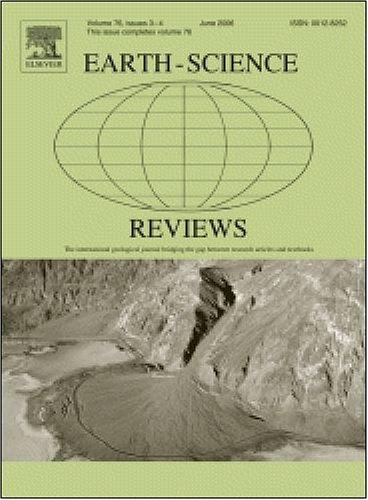Polycyclic Andean-type orogenic evolution of the Dunhuang block in NW China: A result of Paleozoic reconfiguration of oceanic subduction systems
IF 10.8
1区 地球科学
Q1 GEOSCIENCES, MULTIDISCIPLINARY
引用次数: 0
Abstract
Despite numerous studies of metamorphic and magmatic rocks from the Dunhuang block, its protracted Cambrian to Permian geodynamic evolution as well as its role in the final amalgamation of the Tarim−North-China Craton Collage during the Pangea assembly, remain controversial. In order to understand the evolution of the Dunhuang block in the frame of Paleozoic plate tectonics, we review and synthetize recently published P−T data along with geochronological and geochemical data for its northern, central and southern mountain ranges, which we placed in the context of structural observations. Zircon and monazite U−Pb ages combined with P−T constraints determined for Ordovician to Devonian metamorphic rocks reveal that M1 and M2 metamorphic events define a clockwise P−T evolution and distinctly hot metamorphic gradients. Ordovician to Devonian protracted garnet growth evidenced by low (Yb/Gd)N ratios in metamorphic zircon and monazite, together with low Th/U ratios, negative εHf(t) and Eu anomalies in magmatic and metamorphic zircon, mark a period of continuous metamorphism accompanied by crustal reworking during thickening of a previously thermally softened crust. Zircon and monazite U−Pb ages suggest that the early Paleozoic D1-M1 and D2-M2 events started ca. 10 m.y. earlier and lasted longer in the northern and central ranges compared to the southern range consisting of significantly older crustal basement components. In all three mountain ranges, the formation of an E-W trending steep cleavage related to D3-M3 event was concomitant with emplacement of numerous late Devonian to Carboniferous diorites and I-type granitoids. The negative εHf(t) of magmatic zircon and high (Yb/Gd)N ratios in metamorphic zircon and monazite show that a magma-assisted N-S-directed shortening event responsible for further crustal reworking started in the late Devonian and lasted over 60 m.y. The latest Permian M4 metamorphic event, restricted mainly to the southern range, defines anticlockwise P−T paths associated with the emplacement of high-K calc-alkaline granitoids. This event is characterized by the increasing from negative to positive zircon εHf(t) values, suggesting input of juvenile crustal and mantle-derived material. High metamorphic gradients and the petrogenesis of magmatic arc-related rocks intruding a Precambrian basement suggest that the Dunhuang block developed as a supra-subduction continental hot orogenic system formed above subducting oceanic plates similar to the northern and southern margins of the American Cordillera. Our data show that its evolution was related to two kinematically independent early to middle and late Paleozoic orogenic cycles. In the context of plate tectonic reconstructions, the revised chronology of events points to the kinematic interplay between the continental blocks moving within the Proto-Tethys oceanic domain in association with the south-dipping Panthalassa, Paleo-Asian, and north-dipping Paleo-Tethys oceanic subduction systems.
敦煌地块多旋回安第斯型造山演化:古生代大洋俯冲体系重构的结果
尽管对敦煌地块的变质岩和岩浆岩进行了大量研究,但其漫长的寒武纪至二叠纪地球动力学演化及其在泛大陆组合期间塔里木-华北克拉通拼合中的作用仍然存在争议。为了更好地理解敦煌地块在古生代板块构造框架下的演化过程,我们回顾并综合了近年来发表的敦煌地块北、中、南部山脉的P−T资料以及地质年代学和地球化学资料,并将其置于构造观测的背景下。锆石和独石U - Pb年龄结合奥陶系—泥盆系变质岩的P - T约束条件表明,M1和M2变质事件定义了顺时针的P - T演化和明显的热变质梯度。奥陶系—泥盆系石榴石生长发育,表现为变质锆石和独一石的低(Yb/Gd)N比值,岩浆锆石和变质锆石的低Th/U比值、负εHf(t)和Eu异常,标志着在热软化的地壳增厚过程中经历了持续变质和地壳改造的时期。锆石和独居石U−Pb年龄表明,早古生代D1-M1和D2-M2事件在北部和中部地区开始的时间比南部地区更早,持续时间也更长。在这三个山脉中,东西向陡解理的形成与D3-M3事件有关,并伴有大量晚泥盆世—石炭世闪长岩和i型花岗岩的侵位。岩浆锆石的εHf(t)为负,变质锆石和独一石的高(Yb/Gd)N比值表明,岩浆作用下的N- s定向缩短事件开始于晚泥盆世,持续时间超过60m .最新的二叠纪M4变质事件主要局限于南缘,确定了与高钾钙碱性花岗岩侵位相关的逆时针P - t路径。该事件的锆石εHf(t)值由负向正逐渐增大,表明有幼年壳幔源物质的输入。高变质梯度和侵入前寒武纪基底的岩浆弧相关岩石的成因表明,敦煌地块形成于类似于美洲科迪勒拉南北边缘的俯冲洋板块之上的超俯冲大陆热造山系统。研究表明,其演化与早、中、晚古生代两个运动独立的造山旋回有关。在板块构造重建的背景下,修正的事件年表指出了在原特提斯洋域内移动的大陆块体之间的运动学相互作用,与南倾的泛地中海、古亚洲和北倾的古特提斯洋俯冲系统有关。
本文章由计算机程序翻译,如有差异,请以英文原文为准。
求助全文
约1分钟内获得全文
求助全文
来源期刊

Earth-Science Reviews
地学-地球科学综合
CiteScore
21.70
自引率
5.80%
发文量
294
审稿时长
15.1 weeks
期刊介绍:
Covering a much wider field than the usual specialist journals, Earth Science Reviews publishes review articles dealing with all aspects of Earth Sciences, and is an important vehicle for allowing readers to see their particular interest related to the Earth Sciences as a whole.
 求助内容:
求助内容: 应助结果提醒方式:
应助结果提醒方式:


